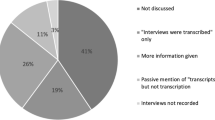Abstract
Four undergraduate volunteers, two women and two men, transcribed an audiotaped interview of former United States President Ronald Reagan by Dan Rather. Their first transcript was made from a single complete playing, with only pausing, but no repetition or replay allowed. Thereafter, two of the transcribers made corrections by an “on-line” method—complete playings as often as they wished. The two others were allowed an “off-line” method—unlimited playback of any portions. None produced a verbatim transcription, but all preserved semantic content quite well. Still, deletions were numerous, particularly of discourse markers and hesitation phenomena, both of which characterize spoken, not written discourse. Significantly more deletions in the on-line than in the off-line condition indicated the difficulty of audiotape processing without off-line replay. These results are discussed in light of recent theories of speech processing.
Similar content being viewed by others
References
Bock, J. K., & Kroch, A. S. (1989). The isolability of syntactic processing. In G. Carlson and M. K. Tanenhaus (Eds.),Linguistic structure in language processing (pp. 157–196). Dordrecht, The Netherlands: Kluwer Academic Publishers.
Button, G., & Lee, J. R. E. (Eds.). (1987).Talk and social organization. Clevedon, England: Multilingual Matters.
Chafe, W. (1982). Integration and involvement in speaking, writing, and oral literature. In D. Tannen (Ed.),Spoken and written language: Exploring orality and literacy (pp. 35–53). Norwood, NJ: Ablex.
Dell, G. S., & Reich, P. A. (1980). Toward a unified model of slips of the tongue. In V. A. Fromkin (Ed.),Errors in linguistic performance: Slips of the tongue, ear, pen, and hand (pp. 273–286). New York: Academic Press.
Ferber, R. (1991). Slip of the tongue or slip of the ear? On the perception and transcription of naturalistic slips of the tongue.Journal of Psycholinguistic Research, 20, 105–122.
Fromkin, V. A. (1971). The non-anomalous nature of anomalous utterances.Language, 47, 27–52.
Fromkin, V. A. (1980). Introduction. In V. A. Fromkin (Ed.),Errors in linguistic performance: Slips of the tongue, ear, pen, and hand (pp. 1–12). New York: Academic Press.
Garrett, M. F. (1976). Syntactic processes in sentence production. In R. J. Wales and E. Walker (Eds.),New approaches to language mechanisms (pp. 231–256). Amsterdam: North-Holland.
Garrett, M. F. (1980). The limits of accommodation: Arguments for independent processing levels in sentence production. In V. A. Fromkin, (Ed.),Errors in linguistic performance: Slips of the tongue, ear, pen, and hand (pp. 263–272). New York: Academic Press.
Garrett, M. F. (1982). Production of speech: Observations from normal and pathological language use. In A. W. Ellis (Ed.),Normality and pathology in cognitive functions. London: Academic Press.
Hörmann, H. (1986).Meaning and context: An introduction to the psychology of language. (R. E. Innis, Ed.), New York: Plenum Press.
Hotopf, W. H. N. (1980). Semantic similarity as a factor in whole-word slips of the tongu. In V. A. Fromkin (Ed.),Errors in linguistic performance: Slips of the tongue, ear, pen, and hand (pp. 97–110). New York: Academic Press.
Jefferson, G., (1989). Preliminary notes on a possible metric which provides for a ‘standard maximum’ silence of approximately one second in conversation. In D. Roger & P. Bull (Eds.),Conversation: An interdisciplinary perspective (pp. 166–196). Clevedon, England: Multilingual Matters.
Labov, W. (1984). Intensity. In D. Schiffrin (Ed.),University round table on languages and linguistics, 1984. Washington, DC: Georgetown University Press.
Lapointe, S., & Dell, G. (1989). A synthesis of some recent work in sentence production. In G. Carlson and M. K. Tanenhaus (Eds.),Linguistic structure in language processing (pp. 107–156). Dordrecht, The Netherlands: Kluwer Academic Publishers.
Levelt, W. J. M. (1989).Speaking: From intention to articulation. Cambridge, MA: The MIT Press.
Lindsay, J. S. (1988).I can't believe my ears: A study of errors in transcription. Unpublished manuscript.
McKay, D. G. (1980). Speech errors: Retrospect and prospect. In V. A. Fromkin (Ed.),Errors in linguistic performance: Slips of the tongue, ear, pen, and hand(pp. 319–332). New York: Academic Press.
Meringer, R. (1908).Aus dem leben der sprache.Berlin: B. Behr.
Meringer, R., & Mayer, C. (1895).Versprechen und verlesen: Eine psychologisch-linguistische studie. Stuttgart: Göschenische Verlagsbuchhandlung.
Ochs, E. (1979). Transcription as theory. In E. Ochs & B. B. Schieffelin (Eds.),Developmental pragmatics (pp. 43–72). New York: Academic Press.
O'Connell, D. C., & Kowal, S. (1990a). A note on time, timing, and transcriptions thereof.Georgetown Journal of Languages and Linguistics, 1, 203–208.
O'Connell, D. C., & Kowal, S. (1990b). Some sources of error in the transcription of real time in spoken discourse.Georgetown Journal of Languages and Linguistics, 1, 453–466.
O'Connell, D. C., & Kowal, S. (1991).The transcriber as language user. Unpublished Manuscript.
Schiffrin, D. (1987).Discourse markers. Cambridge, England: Cambridge University Press.
Shattuck-Hufnagel, S. (1979). Speech errors as evidence for a serial-ordering mechanism in sentence production. In W. E. Cooper and E. C. T. Walker (Eds.),Sentence processing: Psycholinguistic studies presented to Merrill Garrett (pp. 295–342). Hillsdale, NJ: Erlbaum.
Author information
Authors and Affiliations
Additional information
The authors wish to acknowledge gratefully the help of the four students who served as volunteer transcribers: Arthur Anger, Rhonda McKitten, Alison Miller, and William Walsh. The second author wishes to acknowledge with gratitude a Study Visit grant to Germany from the Deutsche Akademische Austauschdienst for the summer of 1993, which partially supported this project.
Rights and permissions
About this article
Cite this article
Lindsay, J., O'Connell, D.C. How do transcribers deal with audio recordings of spoken discourse?. J Psycholinguist Res 24, 101–115 (1995). https://doi.org/10.1007/BF02143958
Received:
Issue Date:
DOI: https://doi.org/10.1007/BF02143958




